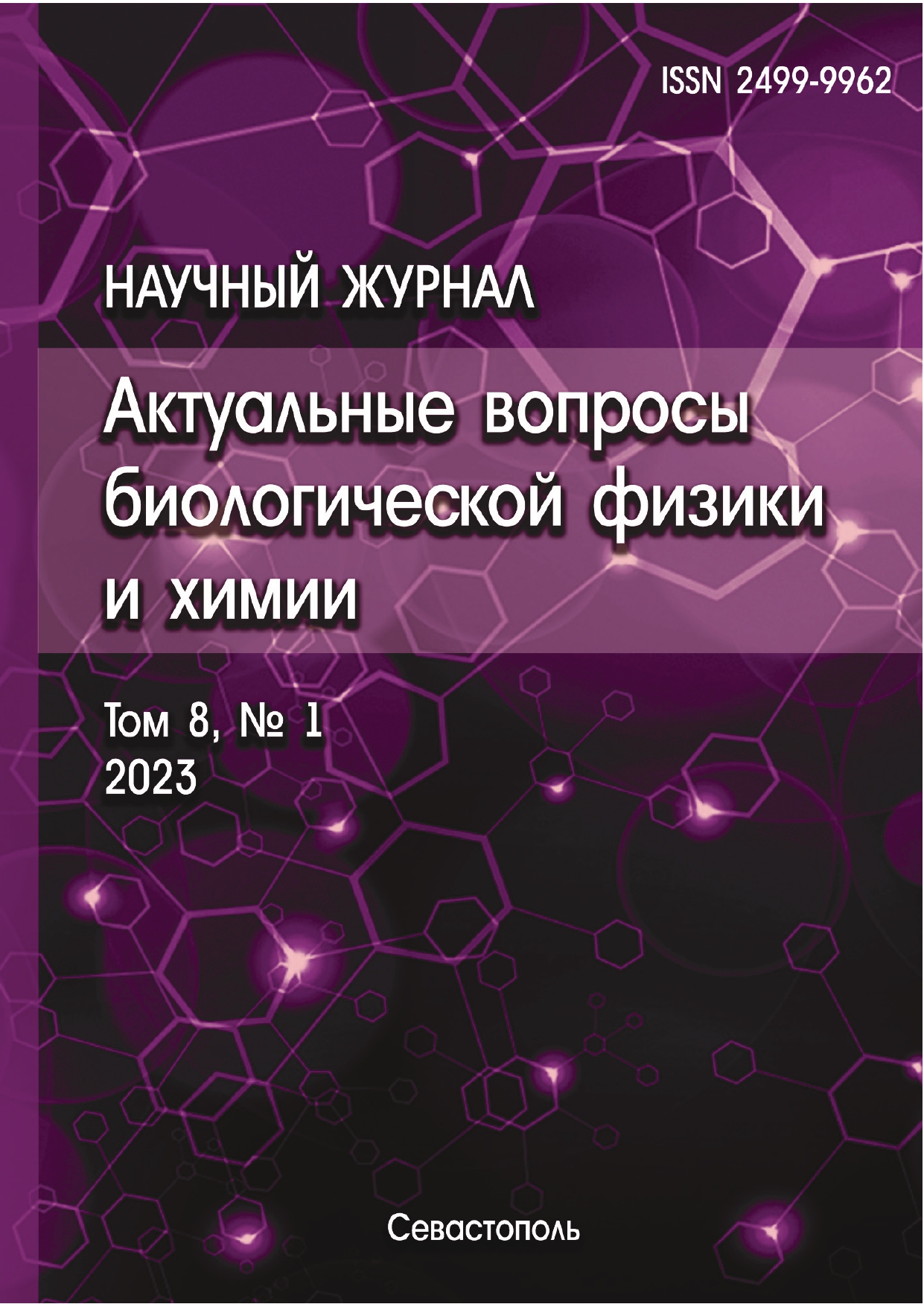Moscow, Moscow, Russian Federation
Moscow, Moscow, Russian Federation
Moscow, Moscow, Russian Federation
Moscow, Moscow, Russian Federation
Moscow, Moscow, Russian Federation
Effect of the divalent copper and iron ions on their ability to form complexes with phospholipids and the lipid peroxidation processes intensity, to affect the self-aggregation of the natural lipids in the water medium and ξ-potential of formed particles are studied in the wild range of the metal ion concentrations. Mathematical analysis of UV-spectra of the water solutions of lecithin, metal ions and their mixtures by Gauss method is revealed that copper and iron ions form complexes with phospholipids and act on content of the oxidation products. Besides, the scale of effect depends on the ion concentration, its nature and the lipid oxidizability. The absence of the linear dependence of the ξ-potential value for the lecithin particles on the ion concentration in the water medium and the essential differences of their ability to act on size of formed by lecithin aggregates are obtained. The obtained data allow us to conclude that quality of the natural water is due to both concentrations of the heavy metal ions and their ability to act on the lipid peroxidation regulatory system parameters of the inherent in water bio-objects.
lecithin, divalent copper and iron ions, UV-spectrometry, Gauss method, formation of micelles, ξ-potential
1. Gurikov YU.V., Bondarenko N.F. Natural water as an oxidizing system. Russ. J. Phys. Chem. A, 2001, vol. 75, no. 7, p. 1103-1006 (In Russ.). EDN: https://elibrary.ru/MHZRXN
2. Konovalov A.I., Ryzhkina I.S. Formation of nanoassociates as a key to understanding of physicochemical and biological properties of highly dilute aqueous solutions. Russ Chem Bull, 2014, vol. 63, pp. 1-14 (In Russ.). EDN: https://elibrary.ru/SXZEYZ
3. Palmina N.P., Maltseva E.L., Chasovskaya T.E. Effect of dilute solutions of biologically active substances on cell membranes. Biophysics, 2014, vol. 59, pp. 577-587 (In Russ.). EDN: https://elibrary.ru/TGDSDP
4. Vigo Pelfrey C. Membrane Lipid Oxidation. Ed. Boston: CRC Press, 1991, vol. III, 300 p.
5. Shvydkiy V.O., Shtamm E.V., Skurlatov Yu.I., Vichutinskaya E.V., Zaitseva N.I., Semenyak L.V. Intoxication of the Natural Aqueous Medium Resulting from Disbalan of Redox and Free Radical Intrabacin Processes. Russ. J. Phys. Chem. B, 2017, vol. 11, no. 4, pp. 643-651, doi:https://doi.org/10.1134/S1990793117040248. EDN: https://elibrary.ru/XNUBRS
6. Burlakova Ye.B., Pal’mina N.P., Mal’tseva Ye.L. A physicochemical system regulating lipid peroxidation in membrane during tumor growth. Membrane Lipid Oxidation, 1991, vol. III, pp. 209-237.
7. ShishkinaL.N., KushnirevaYe.V., Smotryaeva M.A. A new approach to assessment of biological consequences of exposure to low-dose radiation. Radiaz. Biologiya. Radioekologiya, 2004, vol. 44, no. 3, pp. 189-295 (In Russ.). EDN: https://elibrary.ru/OXCGVD
8. Shishkina L.N., Kozlov M.V., Povkh A.Yu., Shvydkiy V.O. Role of lipid peroxidation in the assessment of the consequences of exposure to chemical toxicants on bio-objects. Russ. J. Phys. Chemistry B, 2021, vol. 15, no 5, pp. 57-63 (In Russ.). DOI: https://doi.org/10.31857/S0207401X21090089; EDN: https://elibrary.ru/VBYLSH
9. Shvydkiy V., Dolgov S., Dubovik A., Kozlov M., Povkh A., Shishkina L., Duca G. New Aspects for the Estimation of the State of the Natural Water. Chemistry Journal of Moldova, 2022, vol. 17, no. 2, pp. 35-42, doi:https://doi.org/10.19261/cjm.2022.973. EDN: https://elibrary.ru/WZZHAW
10. Shishkina L.N., Dubovik A.S., Kozlov M.V., Povkh A.Yu., Shvydkiy V.O. Model systems for the estimation of action of compobebts of the water medium on the biological objects. Russian Journal of Biological Physics and Chemisrty, 2022, vol. 7, no. 1, pp. 160-165 (In Russ.). DOI: https://doi.org/10.29039/rusjbpc.2022.0499; EDN: https://elibrary.ru/UQOCBO
11. Shishkina L.N., Klimovich M.A., Kozlov M.V. Similarity Functioning of the Physicochemical Regulatory System on the Membrane and Organ Levels. Pharmaceutical and Medical Biotechnology. New Perspective, N.Y.: Nova Science Publishers, 2013, pp. 151-157.
12. Findley J.B.C., Evanz W.H. Biological membranes: methods. Moscow, 1990, 423 p. (In Russ.).
13. Brin E.F., Travin S.O. Modeling of mechanisms of chemical reactions. Khimicheskaya fizika, 1991, vol. 10, no. 6, pp. 830-837 (In Russ.).
14. Ohgami R.S., Campagna D.R., VcDonald A., Fleming M.D. The Steap proteins are metalloreductases. Blood, 2006, vol. 108, no 4, pp. 1388-1394.
15. Shawki A., Anthony S.R., Nose Y., Engevik M.A., Niespodzany E.J. Intestinal DMT1 is critical for iron absorption in the mouse but is not required for the absorption of copper and manganese. Am. J. Physiol. Gastrointest Liver Physio, 2015, vol. 309, pp. G635-G647, doi:https://doi.org/10.1152/ajpgi.00160.2015.










